How to choose a household grease trap under the sink and install by yourself
One of the most unpleasant problems that can arise with sewage in the kitchen is clogging. If excess fat enters the system, the internal surface of the pipes gradually becomes overmolded. Over time, the deposits narrow the lumen of the tube, and the water stagnates. This limits the functionality of the entire system, and the kitchen appears a heavy smell. The constant struggle against the clogs is very tiring. You can prevent them by installing a grease trap under the sink. Consider what this device is and how to make it yourself.
Useful device for the prevention of blockages
Of course, there must be an effective means for cleaning the sewerage in the house, but if you have to use it constantly, it is easier to prevent clogging. To do this, put household grease trap under the sink.

Plastic grease collector
The design of the device is very simple. The device consists of a body with a partition dividing it into compartments, a flow dampener and a gas outlet with a vent tube. Depending on the purpose and amount of waste, the devices can be of different sizes and differ in design.

The Polish zhalolovka JPR AQUA
The principle of operation is based on the difference in the density of water and fat. If the liquid is cool, the fat cools and rises to the surface in the form of clots. Water enters the second compartment, and then – into the sewer. Fat is retained in the first chamber due to the septum.
When the container is filled, it is cleaned, removing a lot of fat, and reconnected to the system for further work. The cleaning method depends on the type and volume of the device. Household grease removers are easy to clean by hand, and from large structures dirt is pumped out by pumps.

Scheme: grease collector design
Video: device and operating principle of the device
What are the benefits of a grease bag under the sink
Grease-collecting devices are used in many cafes, restaurants and bars, at industrial enterprises that produce dairy products, bakeries, etc. In private houses they began to be used relatively recently, but very successfully.

Scheme: the principle of the device
Owners note such advantages of the grease cap under the sinks:
- Simple construction. Thanks to the simple design of the grease trap it can be assembled by hand. The main thing is to find a container of suitable volume.
- Easy installation. Any person can mount and connect the device to the sewer network. Enough skills in dealing with simple tools.
- Minimal maintenance. If the household grease trap is cleaned at least once every two weeks, there will be no problems with it. Additional prophylaxis may be required only for large industrial installations.
- Efficiency. The device really reliably protects the sewer from blockages. The collected fat remains in the container and does not go any further. floats on the surface of the water. The sewer can only get a small amount, which is not enough to form deposits on the walls of pipes.
- Ability to install several grease collectors under the sink. Sometimes it is impossible to make the adaptation of the required volume or an additional “level of protection” is required. In this case, two devices can be connected in series, the second of which will be used for post-treatment of drains.

Compact gutter under the sink
Materials for the manufacture of grease traps
The most popular materials from which fat separators are made are fiberglass, plastic, galvanized or stainless steel. Devices from them differ in strength, durability, price. When choosing a device for a particular kitchen, you should determine your priorities and focus on the operating conditions.

Plastic container for grease
Option # 1: Plastic
Household grease collectors for washing are made from plastic more often. It is an inexpensive material that is not afraid of corrosion, chemicals and is capable of serving up to 30 years. The merits of plastic also include simplicity in care. To the disadvantages is a weak resistance to mechanical damage.
There are models of different shapes, sizes, with different throughput. They are bought for installation in apartments, private houses, small restaurants, cafes, pubs. Well-proven plastic separators of the fat of the domestic trade mark “The Fifth Element”.

Plastic grease
Option # 2: GRP
A good choice – grease filters under the sink, made of fiberglass. This is an option for self-contained sewerage systems for catering outlets, industrial plants or private homes where a fat separator with high capacity is needed.
The main advantage of fiberglass housings is the high resistance to external influences. The material is so strong that the instruments can be installed outdoors. Fiberglass grease separators are light in weight. They are very easy to mount, use and clean. As for the manufacturers, special attention should be paid to Ecoline models.

Fiberglass grease trap
Option # 3: steel
Usually, fat separators are made of stainless steel, less often – from galvanized. Advantages of the material are obvious: it is durable, resistant to mechanical damage, chemical influences. Devices made of stainless steel are more expensive, but they differ in better quality than devices made of galvanized steel.

Stainless steel model
Stainless steel looks nice, so grease traps can be installed, not masking, not only under the sink, but also at a distance from it. These models are resistant to corrosion, so they can serve for decades without repairs. The disadvantages are a relatively large mass. Steel grease traps are more difficult to install than plastic and fiberglass ones.
Choosing a trademark, it is worth paying attention to the products of the ASO Group. These are not expensive fat separators, but there is no claim to their quality. In the company’s assortment there are household and industrial models intended for both indoor and outdoor installation.

Steel model ASO
Where can I install a grease separator
There are two options for installing grease trap – indoors or outdoors. Manufacturers of instruments often choose a certain “specialization” and produce devices of the same type – for installation inside or outside the building.

Plastic grease separator
Models for installation indoors
Models for indoor installation can be installed in the kitchen, in a separate room or even in the basement. The choice of location should be based on the convenience of operation and maintenance. The ideal option is to install a grease trap under the sink, but in some cases this is not possible.
Not the least role in choosing a place is played by the issue of fire safety. If it is not possible to mount the instrument at a sufficient distance from sources of open fire, it is better not to risk it.
Attention! Fat easily ignites, burns for a long time and is difficult to extinguish. If the stove is too close to the sink, then the grease trap should be installed in a different room.

Cleaning the grease collector
Features of operation of street greasers
Street grease separators are characterized by higher productivity than those designed for installation under the sink. They are made of fiberglass or stainless steel and buried in the ground. Well-proven models of the STK series.
The installation technique is quite simple, but it involves laborious work – excavation, concreting, etc. Therefore, it is better to instruct the professional masters to install the grease trap on the street. Also it is necessary to take care of additional devices facilitating the operation of separators, for example, special sensors that control the level of deposits.
Note! Cleaning the street grease trap is a complicated procedure, and it is often necessary to seek help from the sewage disposal services. This is an additional cost. They pay for themselves by increasing the time interval between cleansing.
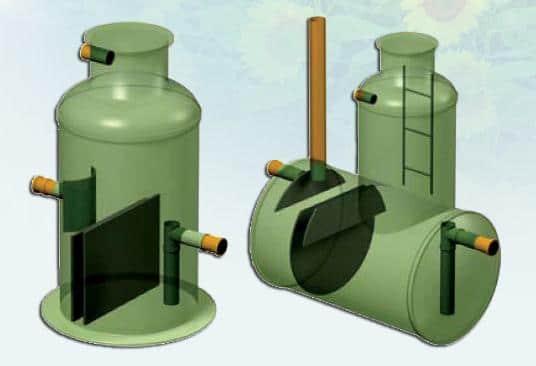
Design of grease trap for outdoor installation
Formulas for calculating technical parameters
When choosing a grease trap for washing or making a device with your own hands, you need to determine the desired technical parameters. The main one is the peak discharge, i.e. the amount of water that can pass the device at a time. For a typical city apartment or a private house, a model with a value of 30-40 l / s is suitable.

Fat of the simplest design
If we are talking about the installation of an industrial model, then it is better to entrust the calculation of technical parameters to specialists. If you plan to buy household equipment, then you can use a simple formula:
P = nxPs, where
P is the required device performance in l / s;
n – the number of shells from which the drains will enter the grease trap;
Ps – the rate at which water will be fed into the tank (it is equal to the rate of water intake in the water supply system and is usually about 0.1 l / s).
Consider, for example, how to calculate the desired performance of the grease trap under the sink. If one wash is connected, then Р = 1х0,1 = 0,1 l / s, i.е. for the kitchen is quite a household model with minimal performance.
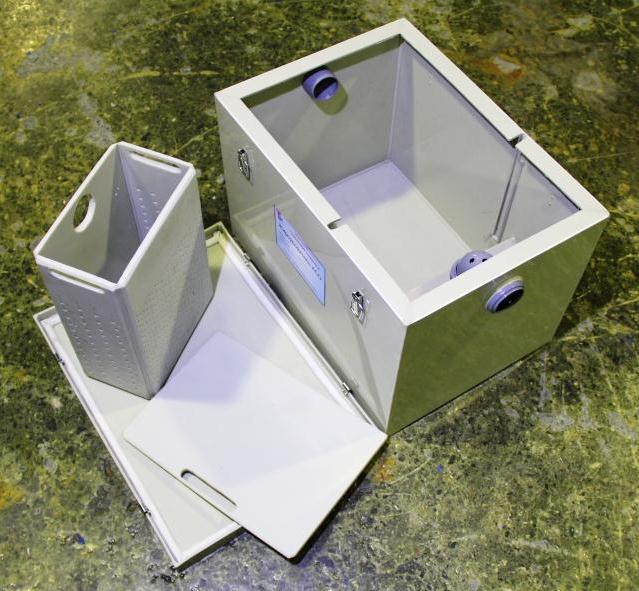
Steel box for grease collector
Based on the data obtained, you can find out the required volume of the container. Calculation formula:
V = 60хPхt, where
V is the required volume in liters;
P – productivity;
t is the time required for the fat to settle in minutes (most often this interval is 6 minutes).
Example of calculation of the required volume, if the capacity is 0.1 l / s: V = 60х0.1х6 = 36 l.
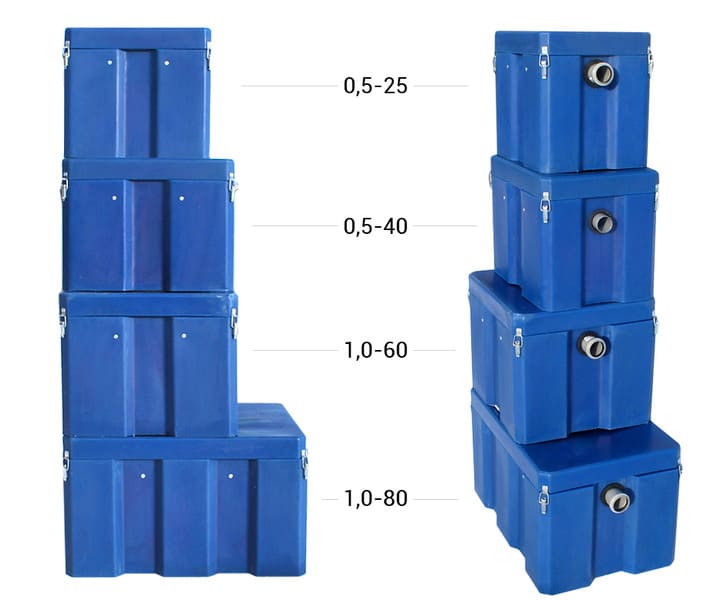
Grease fats of different volumes
Having learned the volume, it is already possible to choose a ready model or to calculate the dimensions of the device if it is planned to produce it independently. The ideal option for a grease trap for washing with a capacity of 0.1 l / s and a volume of 36 liters is a capacity of 0.3×0.3×0.4 m. When choosing a container it is not essential, the height will be 0.3 or 0.4 m.
Based on the data obtained, you can already prepare a sketch and a drawing. An example of a ready-made blueprint with explanations is suggested below.
http://aqua-rmnt.com/wp-content/uploads/2016/05/chertezh-bytovogo-zhiroulovitelya.jpg
Drawing for the manufacture of grease
Top-5 domestic and foreign brands
The design of the grease trap is quite simple, so there is not much difference between models of different manufacturers. The quality of the instruments can be judged from the materials used. The following are the best brands:
- Eurorek. These are the products of Wavin Labko. Fat collectors are distinguished by their durability, strength, resistance to external influences.
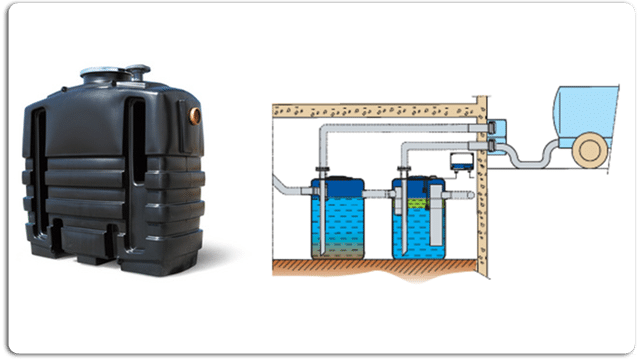
Model EuroRek SL
- The instruments of this company are made of fiberglass. They are universal, functional, durable.
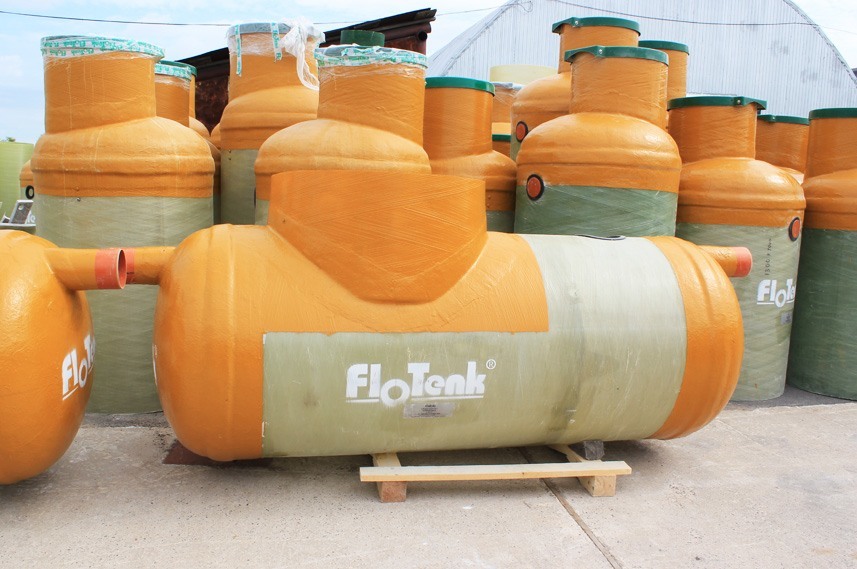
Industrial grease separators Flotenk
- Nelyx. The company specializes in manufacturing industrial grease traps and does not produce household models. This is an excellent option for a cafe, pub or restaurant.

Variety of models
- Evo Stok. Quality domestic products of reinforced plastic and polypropylene. There are household and industrial models.
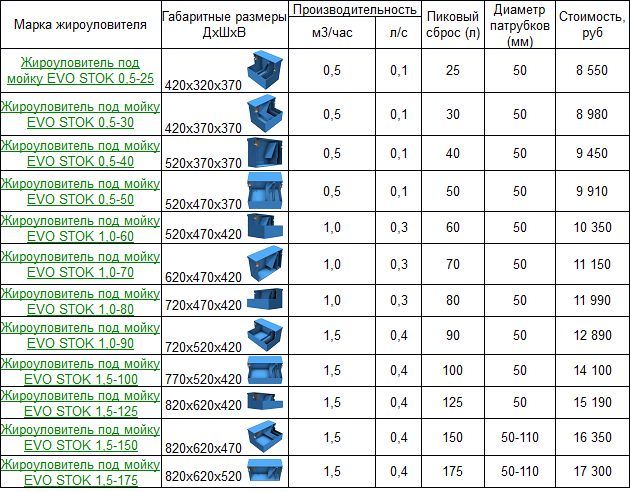
Table: models of the trade mark Evo Stok
- “Fifth Element”. The Russian company manufactures industrial and household grease trap, gives a 5-year warranty on its products and provides maintenance. Another plus is an acceptable price. The model of this company is a good choice for a private home.
Table: household greasers of the brand “Fifth Element”
How to make a grease separator with your own hands
To make a grease trap under the sink with your own hands, you will need the following materials:
- Plastic box, the dimensions of which may be slightly more than calculated, but not less;
- a small branch pipe with a diameter of about 100 mm to create an internal partition;
- Knee and tee PET cross section of 50 mm;
- a piece of pipe 100 mm in diameter, the length of which should be about 2/3 of the height of the box, and a branch with a rubber cuff of the same length but 50 mm in diameter.
You will also need a standard set of tools. Necessarily you need either an electric jigsaw or a saw, which you can cut through the case. Of the additional materials will have to buy sandpaper, silicone sealant, adhesive tape sealant.
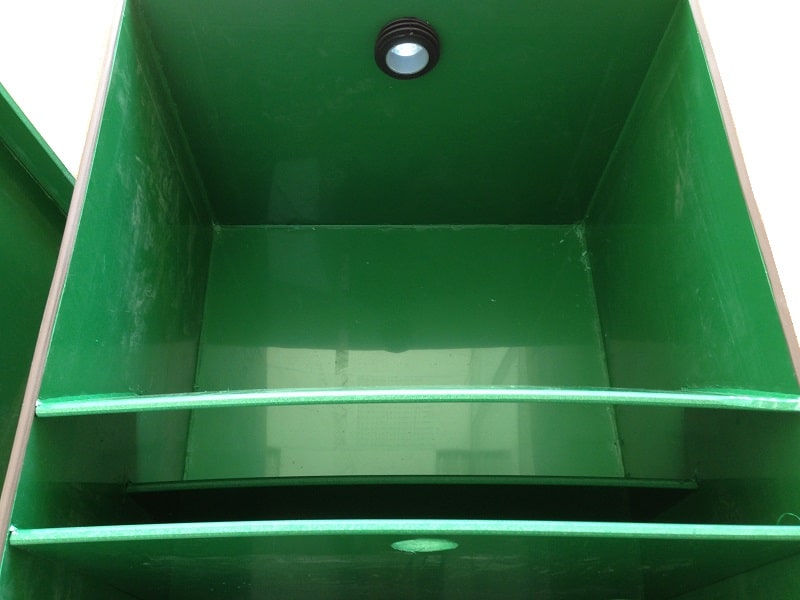
Manufacture of grease trap by own hands
The main stages of work:
- In the end walls of the plastic box, the holes for the branch pipes are sawed, the cut is sheared off.
- Important! The diameter of the holes must coincide with the section of the nozzles. They must come in very tightly. Slots and gaps are unacceptable.
- On the bottom of the container, a piece of pipe with a diameter of 100 mm is glued, and when the compound is completely dry, a piece of pipe with a diameter of 50 mm is inserted inside. The distance from the smaller branch pipe to the bottom should be about 3-4 cm.
- The branch pipe is connected to the discharge drain tee so that the end of the link gets into the outlet. The hole of the tee will be directed upwards. This is necessary for ventilation.
- An inlet knee is connected to the box and sealed with a silicone compound.
- The final touch is the pasting of the edges of the cover with a sealant.
- When the sealing compounds dry out, you can check the operation of the grease trap. It is installed under the sink, connected to the sewer and turn on the water. If the joints do not leak, the device is ready for operation.
Video: features of homemade grease
Rules for installing a grease trap under the sink
- Before starting the installation, make sure that it is positioned correctly. It is necessary to ensure normal access to the device for its maintenance.
- Between the body of the grease trap and the walls of the cabinet in which it will be hidden, there must be a distance of at least 2-3 cm. This is necessary so as not to damage the furniture when the device is turned off for prevention.
- The separator is installed only on a flat surface. The distortions will lead to the fact that the fat will be poured into the sewer.
- When installing, you must strictly follow the manufacturer’s recommendations. The instructions should indicate the optimal distance from the appliance to the cooker and other sources of open flame. This point can not be violated.
- Fats industrial production are completed with special fasteners for installation and connection to the sewage system. If the owner decides to buy the fasteners separately, you need to make sure that you have the correct size.
- After installing the grease trap under the sink, it is connected to the sewer. For this, the corrugation from the main sewage pipe is inserted into the inlet of the device, and another corrugation is connected to the output tee. Joints are sealed with a silicone compound or sealing tape.
Note! Fat thickens and forms a film on the water, if its temperature is below 40 degrees. It is desirable to put the separator away from the siphon so that the drains can cool down before it enters the vessel.
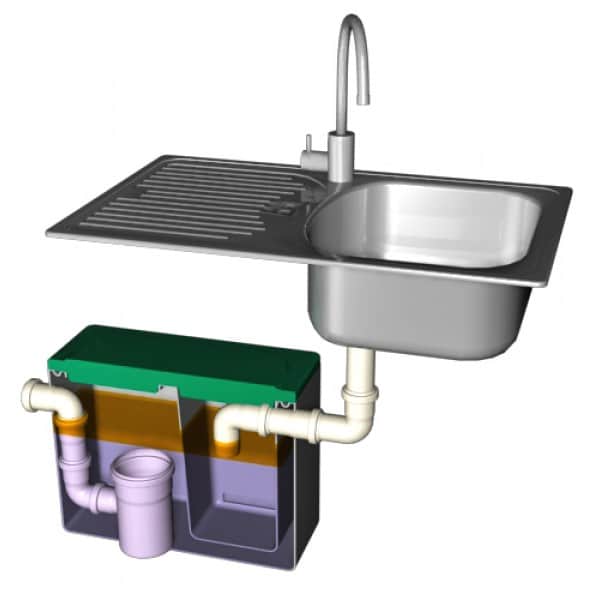
Scheme: installation of a grease separator
Methods for cleaning the reservoirs from deposits
With the cleaning of household greasers under the sink there will be no problems. They are usually of small volume, so they can be easily disconnected from the sewer and cleaned by hand. The productivity of such devices is 0.1-2 l / s. Models of greater productivity are considered industrial, and for their maintenance it is necessary to resort either to pumps or to special equipment.
Industrial models are equipped with automation, which controls the level of pollution and signals the need for preventive maintenance. In household appliances such devices are often not provided, we regularly check the capacity. Below we offer a detailed video instruction on manual cleaning of the fat separator.
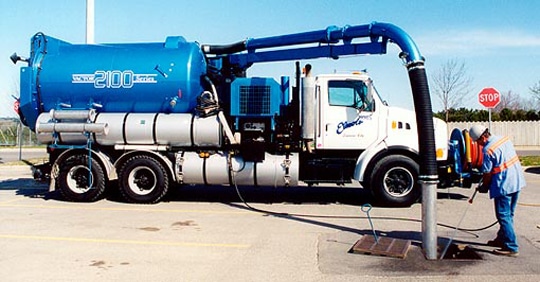
Cleaning the industrial grease trap
Step-by-step video instructions for maintenance
When selecting and manufacturing a grease trap for washing with your hands, pay attention to the quality of the material from which the body is made. The life of the device depends on this. Plastic and fiberglass models do not withstand strong impacts badly, so care must be taken to install the instruments correctly. If you plan to buy an industrial device, give preference to manufacturers who provide a guarantee. Otherwise, the instruments of different brands differ little from each other.


